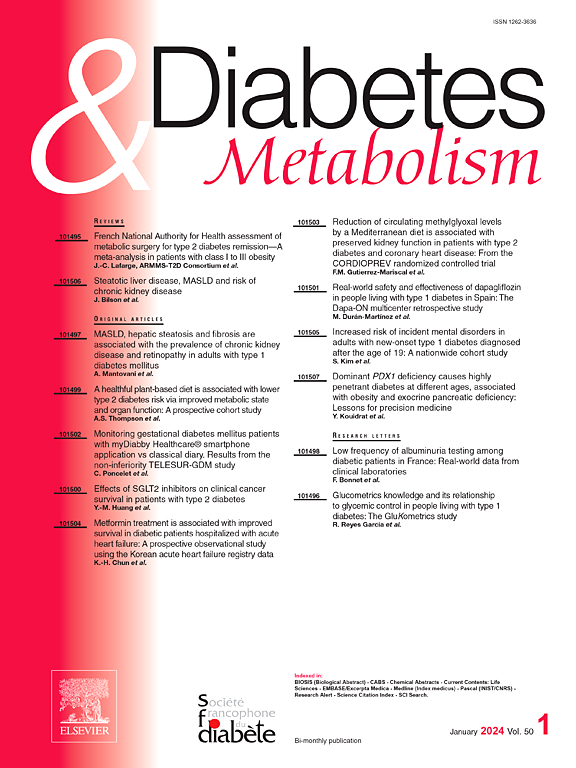无主要心血管危险因素的成人脂肪沉积与死亡率之间的关系
IF 4.7
2区 医学
Q1 ENDOCRINOLOGY & METABOLISM
引用次数: 0
摘要
目的:研究无主要心血管危险因素的美国成年人肥胖与死亡率之间的关系。方法:对2003-2004年、2011-2016年全国健康与营养检查调查(National Health and Nutrition Examination Survey)中7948名年龄在100 ~ 20岁的成年人(女性4123人,男性3825人)进行分析。排除心血管疾病、肾小球滤过率< 60 ml/min/1.73m²、糖尿病、高血压或怀孕的参与者。通过双能x线吸收测量法或人体测量法评估的肥胖测量包括机器人和女性的脂肪质量指数(FMI)、机器人与女性的比例、皮下、腹部和内脏的脂肪质量指数、BMI和腰围。我们采用多变量校正Cox回归和限制性三次样条模型来评估肥胖测量与全因死亡率之间的性别特异性关联。结果:在中位7.8年的随访中,女性死亡83人,男性死亡119人。在女性中,BMI、腰围和雌核FMI与全因死亡率呈非线性关系,而在男性中,BMI、腰围和机器人与雌核之比也表现出类似的非线性关系。在最终调整的模型中,女性内脏、皮下和腹部FMI增加1-SD分别与61% (HR 1.61, 95% CI 1.17-2.21)、87% (HR 1.87, 95% CI 1.13-3.08)和89% (HR 1.89, 95% CI 1.19-2.99)的死亡风险升高相关。低分位的女性与中分位的女性相比,低分位的女性死亡风险高82% (HR 1.82, 95% CI 1.01-3.29)。在最终调整的模型中,男性女性生殖器、android、内脏、皮下和腹部FMI增加1-SD分别与30% (HR 1.30, 95% CI 1.02-1.65)、41% (HR 1.41, 95% CI 1.09-1.83)、54% (HR 1.54, 95% CI 1.04-2.28)、69% (HR 1.69, 95% CI 1.25-2.29)和76% (HR 1.76, 95% CI 1.25-2.48)的死亡风险升高相关。此外,与最低的四分之一相比,中等四分之一的男性死亡风险高出2.68倍,而BMI最高的四分之一的男性死亡风险高出最低的83%。性别改变了雌核FMI与死亡率之间的关系(P-interaction = 0.008)。结论:在没有心血管危险因素的成年人中,基于成像的肥胖测量比传统的人体测量对死亡率有明显的预后价值。本文章由计算机程序翻译,如有差异,请以英文原文为准。
Association between adipose deposition and mortality among adults without major cardiovascular risk factors
Aim
To examine the association between adiposity and mortality in U.S. adults without major cardiovascular risk factors.
Methods
We analyzed 7,948 adults (4,123 women, 3,825 men) aged > 20 years from the National Health and Nutrition Examination Survey (2003–2004, 2011–2016). Participants with cardiovascular disease, estimated glomerular filtration rate < 60 ml/min/1.73m², diabetes, hypertension, or pregnancy were excluded. Adiposity measures, assessed by dual-energy x-ray absorptiometry or anthropometrics, included android and gynoid fat mass index (FMI), android-to-gynoid ratio, subcutaneous, abdominal, and visceral FMI, BMI, and waist circumference. We employed multivariable-adjusted Cox regression and restricted cubic spline models to assess sex-specific associations between adiposity measures and all-cause mortality.
Results
Over a median follow-up of 7.8 years, there were 83 deaths among women and 119 among men. In women, BMI, waist circumference, and gynoid FMI showed non-linear associations with all-cause mortality, while in men, BMI, waist circumference, and android-to-gynoid ratio demonstrated similar non-linear associations. In final adjusted models, a 1-SD increase in visceral, subcutaneous, and abdominal FMI among women was associated with 61 % (HR 1.61, 95 % CI 1.17–2.21), 87 % (HR 1.87, 95 % CI 1.13–3.08), and 89 % (HR 1.89, 95 % CI 1.19–2.99) higher mortality risk, respectively. Women in the lowest tertile of gynoid FMI had an 82 % (HR 1.82, 95 % CI 1.01–3.29) higher mortality risk compared to those in the middle tertile. In final adjusted models, a 1-SD increase in gynoid, android, visceral, subcutaneous, and abdominal FMI among men was associated with 30 % (HR 1.30, 95 % CI 1.02–1.65), 41 % (HR 1.41, 95 % CI 1.09–1.83), 54 % (HR 1.54, 95 % CI 1.04–2.28), 69 % (HR 1.69, 95 % CI 1.25–2.29), and 76 % (HR 1.76, 95 % CI 1.25–2.48) higher mortality risk, respectively. Additionally, men in the middle tertile of android-to-gynoid ratio had a 2.68-fold higher mortality risk compared to the lowest tertile, while men in the highest BMI tertile had an 83 % higher mortality risk compared to the lowest tertile. Sex modified the association between gynoid FMI and mortality (P-interaction = 0.008).
Conclusion
Imaging-based adiposity measures have distinct prognostic value for mortality beyond traditional anthropometrics in adults without cardiovascular risk factors.
求助全文
通过发布文献求助,成功后即可免费获取论文全文。
去求助
来源期刊

Diabetes & metabolism
医学-内分泌学与代谢
CiteScore
12.00
自引率
4.20%
发文量
86
审稿时长
13 days
期刊介绍:
A high quality scientific journal with an international readership
Official publication of the SFD, Diabetes & Metabolism, publishes high-quality papers by leading teams, forming a close link between hospital and research units. Diabetes & Metabolism is published in English language and is indexed in all major databases with its impact factor constantly progressing.
Diabetes & Metabolism contains original articles, short reports and comprehensive reviews.
 求助内容:
求助内容: 应助结果提醒方式:
应助结果提醒方式:


